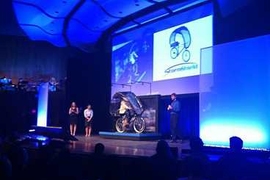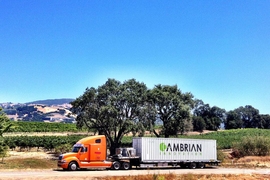Delivering beer and other beverages to bars in Boston and other cities with old infrastructure — where many storage cellars have no elevator access — can damage workers’ health and businesses’ bottom line. Repeatedly bouncing 160-pound kegs down flights of stairs can cause chronic injury for delivery professionals, resulting in time off work, and the impacts can damage the stairs and break the hand truck.
In 2012, a team of students in MIT’s well-known product-design class, Course 2.009, invented a hand truck with fold-out treads and a braking system that made hauling kegs downstairs safer and easier. Now that hand truck, which launched commercially in April and is called the Glyde, is already being used by hundreds of people worldwide. And the MIT spinout selling the product, ELL Operations (ELLO), has landed major partnerships with Anheuser Busch InBev and leading hand-truck manufacturer Magliner.
“With a few hundred Glydes already out in the market, we’re making tens of thousands of deliveries easier every day,” says ELLO CEO John Reynolds ’13, one of the 2.009 student inventors who co-founded ELLO with mechanical engineering classmates Nate Robert ’13, Tyler Wortman PhD ’16, and Chris Benson ’10, SM ’12, PhD ’14.
In Boston alone, Anheuser Busch InBev has a fleet of about 50 delivery trucks. According to ELLO, each day one delivery crew will carry about 75 kegs and 1,000 cases of beer down roughly 180 flights to storage areas at the city’s restaurants and bars. Numbers are similar in other major cities where distributors now use Glyde, including New York City, Philadelphia, Chicago, and several cities in Europe.
With Magliner as a manufacturing and distribution partner, ELLO can produce a few thousand Glyde hand trucks per year. Other beverage clients, such as Pepsi Co., as well as grocery distributors have started using ELLO’s hand truck. In the future, ELLO also plans to sell Glydes to consumers or companies for moving purposes, Reynolds says.
Smoother ride
ELLO’s aim, Reynolds says, “is improving the safety and efficiency of the last 100 meters of delivery” — meaning carting shipments from delivery trucks into businesses. That’s where workers can be injured and equipment can break, which can cost distributors millions of dollars every year in liability and workers compensation, according to Reynolds. “If the moving goods over the last 100 meters has any impacts or delays, it goes right against your bottom line,” he says.
At the core of the Glyde technology is a tensioned continuous tread — like a miniature version of the treads seen on a tank — that unfolds at an angle when needed. When going downstairs, the hand truck rests on that track, which spans two stairs at a time, meaning the hand truck never drops down onto a stair. “So they’re not bouncing over every single step,” Reynolds says. “It’s that jolting down that breaks the body over time.”
The track also has a self-braking system. When the hand truck starts moving too fast, it triggers braking shoes to compress the tread’s axles. A longer handle was also designed to allow the delivery professional to position the load comfortably when going downstairs. “This puts all the weight on the driver’s legs, which reduces back strain,” Reynolds says.
Smoother rides add to the longevity of the hand truck and cut down on wear and tear at the delivery site, Reynolds adds. “Because they don’t have to drop the hand-truck down each stair, you don’t see as much axle bending or frame cracking or damage to the staircases,” Reynolds says.
In addition to developing the Glyde, ELLO is looking to solve another industry issue, where some drivers consistently take easier routes with lighter roads, while others take harder routes with heavier loads. “It isn’t balanced, and because of that, you have a lot of injuries with people who are on the hardest routes all the time,” Reynolds says.
To combat that, ELLO is collecting and analyzing data on deliveries, including acceleration, frequency of delivery, location, and weights of loads for each route, with the aim of quantifying routes that pose the greatest injury risks. Distributers can then better vary those routes, Reynolds says: “We want to give distribution companies the planning tools and data to enable them to make sure their people aren’t getting hurt.”
Data-driven design
From its early days at MIT, ELLO has followed what Reynolds calls “MIT data-driven design.”
In 2012, Reynolds and a student team were tasked with designing a product for Course 2.009 (Product Engineering Processes), where students design products with commercial potential and present them at a major event each December. Brainstorming one morning, the team strolled the streets of Boston. “Trucks were double-parked in front, and delivery men were rolling kegs of beer off the trucks,” Reynolds says. “We started interviewing the drivers and realized that the stairs in the cities with older infrastructure present a huge risk of injury.”
For their 2.009 project, Reynolds and 11 other students designed a prototype hand truck, called the Clydesdale, which functioned similarly to today’s Glyde. Anheuser Busch InBev soon caught wind and began facilitating pilot tests for the invention.
In New York, Boston, and Denver, the team attached electrodes to delivery drivers using traditional hand trucks and the Clydesdale. The electrodes measured the electric activity of drivers’ back muscles — the more muscles activated, the greater the output. The students also attached accelerators and strain gauges on the two types of hand trucks to measure acceleration downstairs and load sizes. In doing so, the team found drivers using the Clydesdale recorded an eightfold reduction in muscle strain and a ninefold decrease in acceleration going downstairs, compared to traditional hand trucks.
In early 2013, after the team’s Clydesdale demonstration for Course 2.009, where Reynolds was a key presenter, Anheuser Busch InBev called Reynolds to buy the intellectual property. Instead, Reynolds looped in two friends, Robert and Benson, to launch ELLO to commercialize the invention. The startup then secured a major partnership with Anheuser Busch InBev, which provided initial funding for research and development, as well as access to some of its U.S. distribution centers.
Throughout his senior year, Reynolds built ELLO with the aid of MIT classes such as Course 6.933 (The Founder’s Journey), Course ESD.051 (Engineering Innovation and Design), and Course 15.S24 (Application of Advanced Entrepreneurial Techniques), as well as numerous mentors at the Martin Trust Center for MIT Entrepreneurship and the Gordon Engineering Leadership program at MIT. Among the major lessons Reynolds learned was the importance of designing a product with consumer psychology in mind. “The biggest hurdle we struggled with was driver adoption,” he says. “The mentality of a driver is to get the drive done as quickly as possible without any regard for safety. The driver needs to feel that [a new technology] is fast and makes the day easier, otherwise they won’t use it.”
With ELLO’s first few prototypes, for instance, it took 30 seconds to unfold and refold the treads and handles. And drivers complained. With urging from MIT mentors, ELLO did a complete redesign for a track that can be unfolded and refolded in two seconds. The product then went through 10 iterations, before its first commercial release this April.
Reynolds attributes much of the current success of Glyde to his early, hands-on experimentation with the product at the Institute: “MIT has a great infrastructure for launching startups. There aren’t many course where you go through case studies — you are the case study.”









